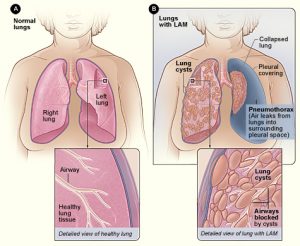Improve the Symptoms of Lymphangioleiomyomatosis, a Rare Lung Disease, with Yoga
By John M. de Castro, Ph.D.
“The daily practice of yoga can help in strengthening the muscles of the chest, increase lung capacity and boost oxygen intake.” – Ayurvalley
Lymphangioleiomyomatosis (LAM) is a very rare lung disease “caused by the abnormal growth of smooth muscle cells, especially in the lungs and lymphatic system. This abnormal growth leads to the formation of holes or cysts in the lung.” (Cleveland Clinic). It is a progressive disease that has symptoms similar to asthma and bronchitis. It is most prevalent in women during the prime of their lives, ages 20 to 40 years. There are no cures for LAM and treatment usually involves drugs that slow the disease progression.
Yoga has been shown to improve exercise tolerance and overall health and includes breathing exercises. Indeed, it has been shown that yoga practice improves the mental and physical health of patients with Chronic Obstructive Pulmonary Disease (COPD). So, it may be appropriate for patients with Lymphangioleiomyomatosis (LAM). Hence, there is a need for research into the effectiveness of yoga practice for LAM.
In today’s Research News article “Effects of yoga on exercise capacity in patients with lymphangioleiomyomatosis: a nonrandomized controlled study.” (See summary below or view the full text of the study at: https://www.ncbi.nlm.nih.gov/pmc/articles/PMC7075042/) Li and colleagues adult patients with lymphangioleiomyomatosis (LAM) who have stable disease and assigned them to either no-treatment or to receive Hatha yoga training for 90 minutes once a week for 24 weeks along with twice a week for 15 minutes home practice. They were measured before and after training for walking and afterward dyspnea, VO2peak and anaerobic threshold during an exercise test, lung function, activity, quality of life, anxiety and depression.
They found excellent participation and compliance with 92% attendance at the yoga training sessions and a median at how practice of 75 minutes per week. They found that in comparison to baseline and the no-treatment control group that the patients who received yoga training there was a significant large improvement in walking, and cardiopulmonary anerobic threshold, and peak workload.
These excellent results have to be tempered by the fact that the yoga and control groups were not randomly assigned. Rather patients within a city were compared to patients outside the city. But, as pilot results, they support a development of a large randomized control trial. The results suggest that yoga practice significantly improves motor function and cardiopulmonary function in patients with lymphangioleiomyomatosis (LAM). This would represent a significant improvement in the patients’ health.
So, improve the symptoms of lymphangioleiomyomatosis, a rare lung disease, with yoga.
“the beneficial effects of yoga on exercise capacity and pulmonary function were the most robust.” – Brandon May
CMCS – Center for Mindfulness and Contemplative Studies
This and other Contemplative Studies posts are also available on Google+ https://plus.google.com/106784388191201299496/posts and on Twitter @MindfulResearch
Study Summary
Li, X., Xu, W., Zhang, L., Zu, Y., Li, Y., Yang, Y., Xiang, Y., Xiang, Y., Chen, L., Liu, W., Chen, L., & Xu, K. F. (2020). Effects of yoga on exercise capacity in patients with lymphangioleiomyomatosis: a nonrandomized controlled study. Orphanet journal of rare diseases, 15(1), 72. https://doi.org/10.1186/s13023-020-1344-6
Abstract
Objective
To evaluate the effects of yoga on exercise capacity and quality of life in patients with lymphangioleiomyomatosis (LAM), a rare cystic lung disease in women.
Patients and methods
This was a nonrandomized, controlled study conducted in Beijing, China (August 27, 2017 – April 26, 2018). Twenty-six participants were allocated to the intervention (yoga) group (n = 13) or control group (n = 13). The yoga intervention involved a 24-week program of yoga class training for 90 min once a week and no fewer than 2 at-home sessions per week (at least 15 min per session). The 6-min walking distance (6MWD), lung function, serum vascular endothelial growth factor-D (VEGF-D) levels, quality of life, and symptoms of anxiety and depression were measured at baseline, 12-week and 24-week follow-up. An incremental cardiopulmonary exercise test was conducted at baseline and the 24-week follow-up.
Results
Eleven patients completed the yoga training program. The yoga group exhibited improvements in the following outcomes versus those of the control group: 6MWD (+ 55 ± 29 m vs + 18 ± 49 m, P = 0.04), anaerobic threshold (3.4 ± 2.4 ml/min/kg vs 1.6 ± 1.4 ml/min/kg, P = 0.035) and peak work load (11.7 ± 14.6 W vs 0.2 ± 9.1 W, P = 0.027). There was no significant difference in peak oxygen consumption (VO2peak), lung function, VEGF-D level, and quality of life between the yoga and control groups. No adverse effects were found in the yoga group.
Conclusion
Yoga is a feasible and safe intervention for pulmonary rehabilitation and potentially improves exercise capacity in patients with LAM.
https://www.ncbi.nlm.nih.gov/pmc/articles/PMC7075042/
